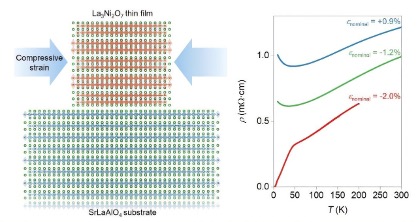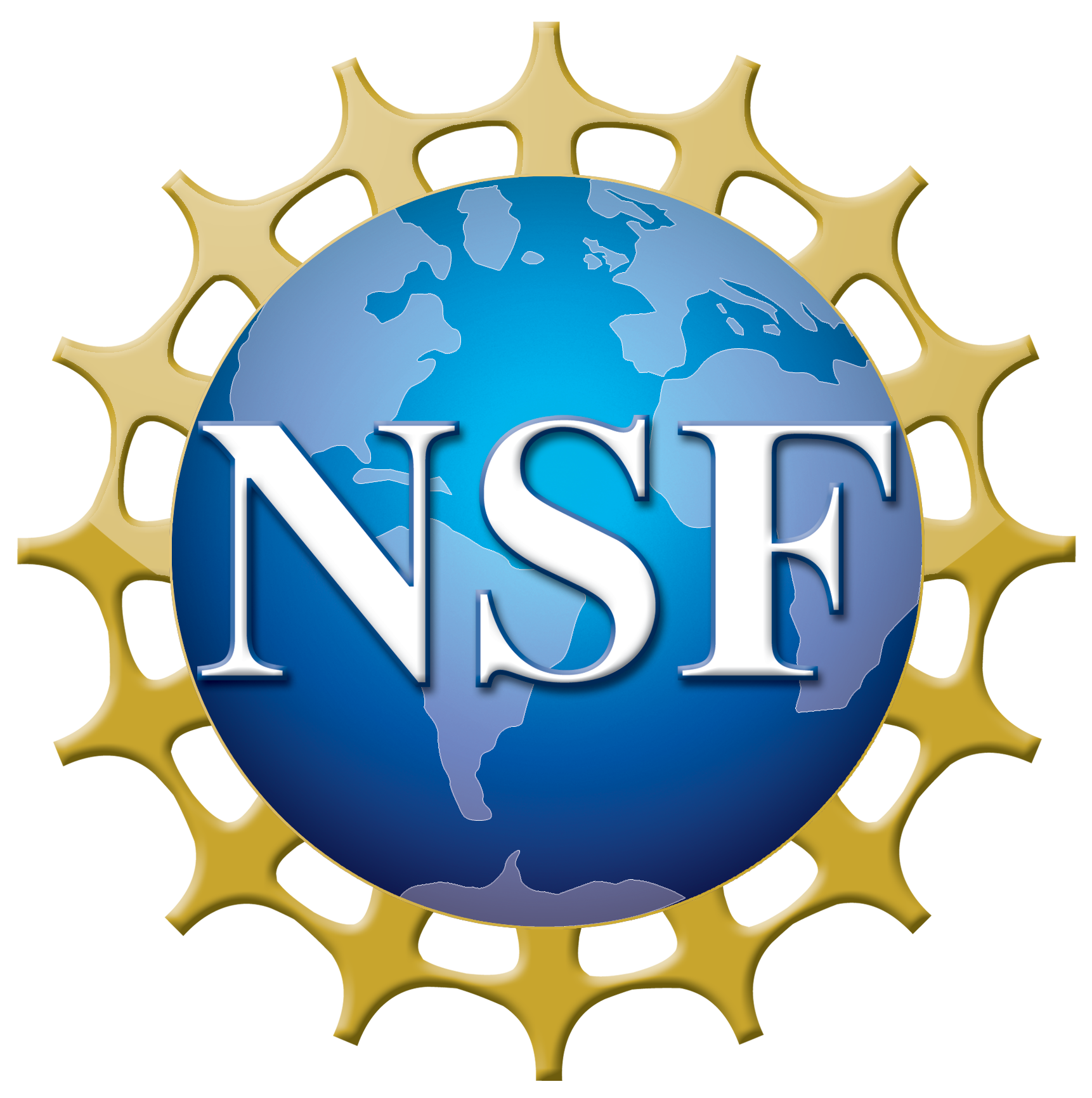PARADIM Highlight #104—External User Project (2025)
Harold Hwang (Stanford) and collaborators
Superconductivity is the ability of certain materials to conduct electricity with zero resistance, and it commonly requires extremely low temperatures and sometimes even high pressures, constraints that not only impede applications but also limit fundamental research. Instead of applying external pressure, a team of Stanford and SLAC researchers lead by Harold Hwang focused on thin-film growth techniques, where the substrates supporting the thin film is used to add lateral compression to the material as the film grows atom by atom and the atomic structure adapts to it. Their approach succeeded in stabilizing superconductivity in the nickelate La3N2O7 at ambient pressure for the first time. Overcoming the limitations of high-pressure constraints enables access to conduct comprehensive studies to expand the understanding of these novel materials.

Figure 1: (left) Schematic of the pressure created in the nickelate film grown on SLAO substrate leading to 2% compressive strain (red curve). (right) Resistivity versus temperature plots of the ozone-annealed films, red curve for the film on SLAO substrate.
PARADIM’s capabilities in high-resolution electron microscopy provided the team with insights into microstructure of the superconducting thin film and the role of defects and the impact of the oxygen content in the nickelate layer.

Recently, the bilayer nickelate La3Ni2O7 has been discovered as a new superconductor with a transition temperature Tc near 80 K under high pressure. Despite extensive theoretical and experimental work to understand the nature of its superconductivity, the requirement of extreme pressure restricts the use of many experimental probes and limits its application potential. Here, the authors present signatures of superconductivity in La3Ni2O7 thin films at ambient pressure, facilitated by the application of epitaxial compressive strain. The onset Tc varies approximately from 26 K to 42 K, with higher Tc values correlating with smaller in-plane lattice constants. We observed the co-existence of other Ruddlesden-Popper phases within the films and dependence of transport behavior with ozone annealing, suggesting that the observed low zero resistance Tc of around 2 K can be attributed to stacking defects, grain boundaries, and oxygen stoichiometry. This finding initiates numerous opportunities to stabilize and study superconductivity in bilayer nickelates at ambient pressure, and to facilitate the broad understanding of the ever-growing number of high temperature and unconventional superconductors in the transition metal oxides.
This discovery challenges long-standing assumptions about how superconductivity works. The team demonstrated that lateral compression from substrates can stabilize the material, even though it differs from the uniform compression achieved through squeezing it evenly from all directions, similar to that produced by a diamond anvil cell. This finding provides new insights into the role of atomic spacing in achieving superconductivity.
PARADIM’s high-resolution electron microscopy capabilities and the ability to rapidly characterize air-sensitive samples before they had degraded.
The work was initiated by Harold Hwang (Stanford University) and included collaborators at the SLAC National Accelerator Laboratory, Cornell University, and the Max Planck Institute for Chemical Physics of Solids (Germany).
E.K. Ko, Y. Yu, Y. Liu, L. Bhatt, J. Li, V. Thampy, C.-T. Kuo, B.Y. Wang, Y. Lee, K. Lee, J.-S. Lee, B.H. Goodge, D.A. Muller, and H.Y. Hwang, "Signatures of ambient pressure superconductivity in thin film La3Ni2O7," Nature 638, 935–940 (2025). DOI: 10.1038/s41586-024-08525-3
We thank Y. Cui, T. P. Devereaux, S. A. Kivelson, R. B. Laughlin, W.-S. Lee, Y. Lin, W. Mao, S. Raghu, Z.-X. Shen and K.-J. Xu for discussions and assistance. This work was supported by the US Department of Energy, Office of Basic Energy Sciences, Division of Materials Sciences and Engineering (contract no. DE-AC02-76SF00515) and the Gordon and Betty Moore Foundation’s Emergent Phenomena in Quantum Systems Initiative (grant no. GBMF9072, synthesis equipment). A part of this work was conducted at the Stanford Nano Shared Facilities (SNSF), supported by the National Science Foundation under grant no. ECCS-1542152. The STEM measurements were performed at the Cornell Center for Materials Research Facilities supported by National Science Foundation (grant no. DMR-1719875). The microscopy work at Cornell was supported by the NSF PARADIM (grant no. DMR-2039380), with further support from Cornell University, the Weill Institute and the Kavli Institute at Cornell. X-ray measurements were carried out at the SSRL, SLAC National Accelerator Laboratory, supported by the US Department of Energy, Office of Science, Office of Basic Energy Sciences (contract no. DE-AC02-76SF00515). Extra support (B.H.G.) was provided by the Max Planck Society and Schmidt Science Fellows in partnership with the Rhodes Trust.







